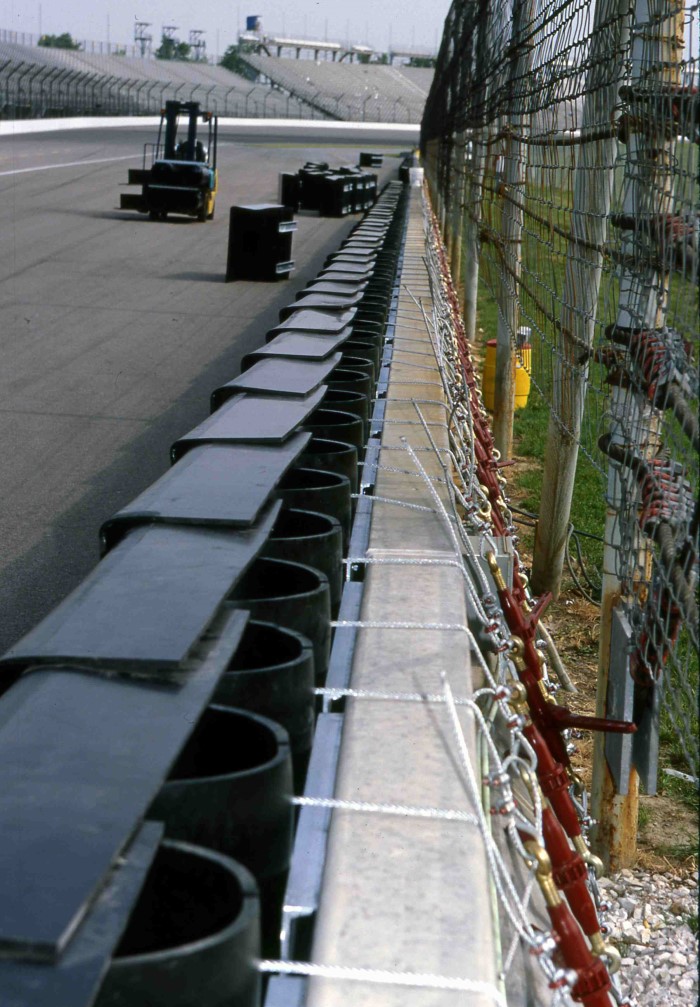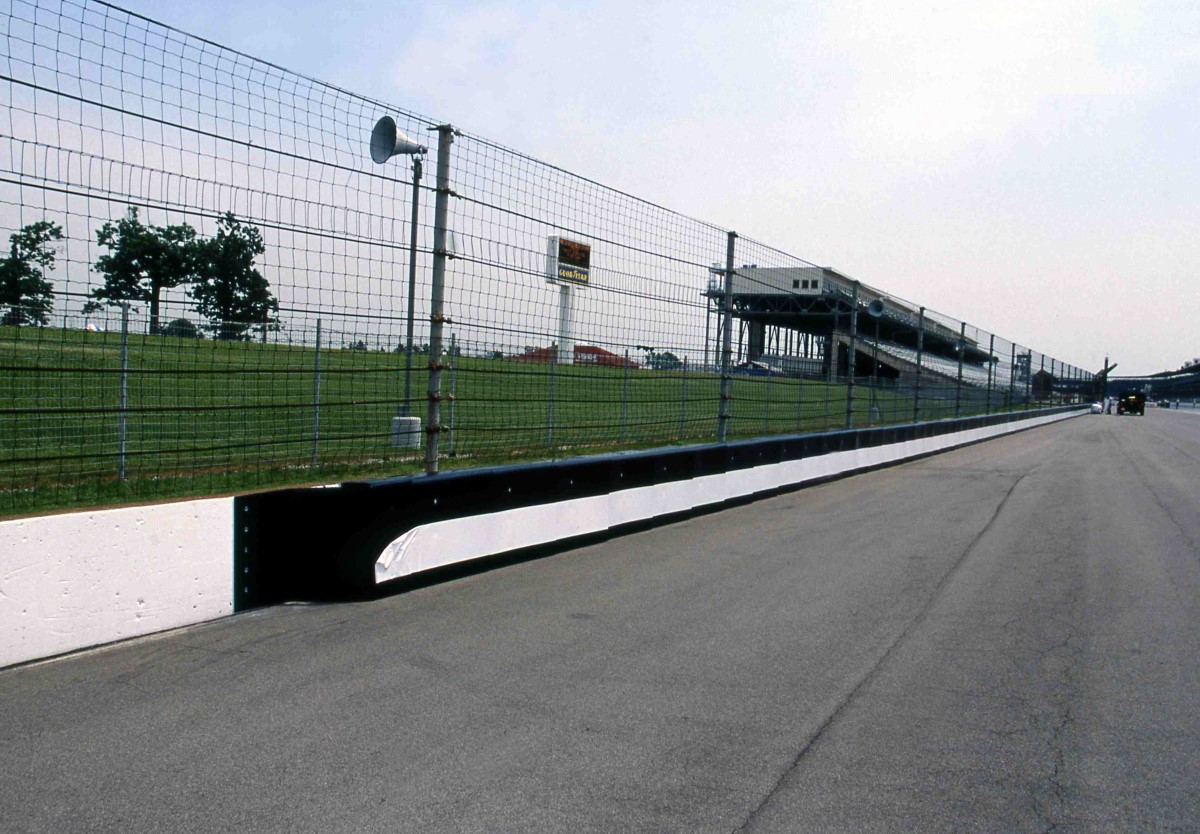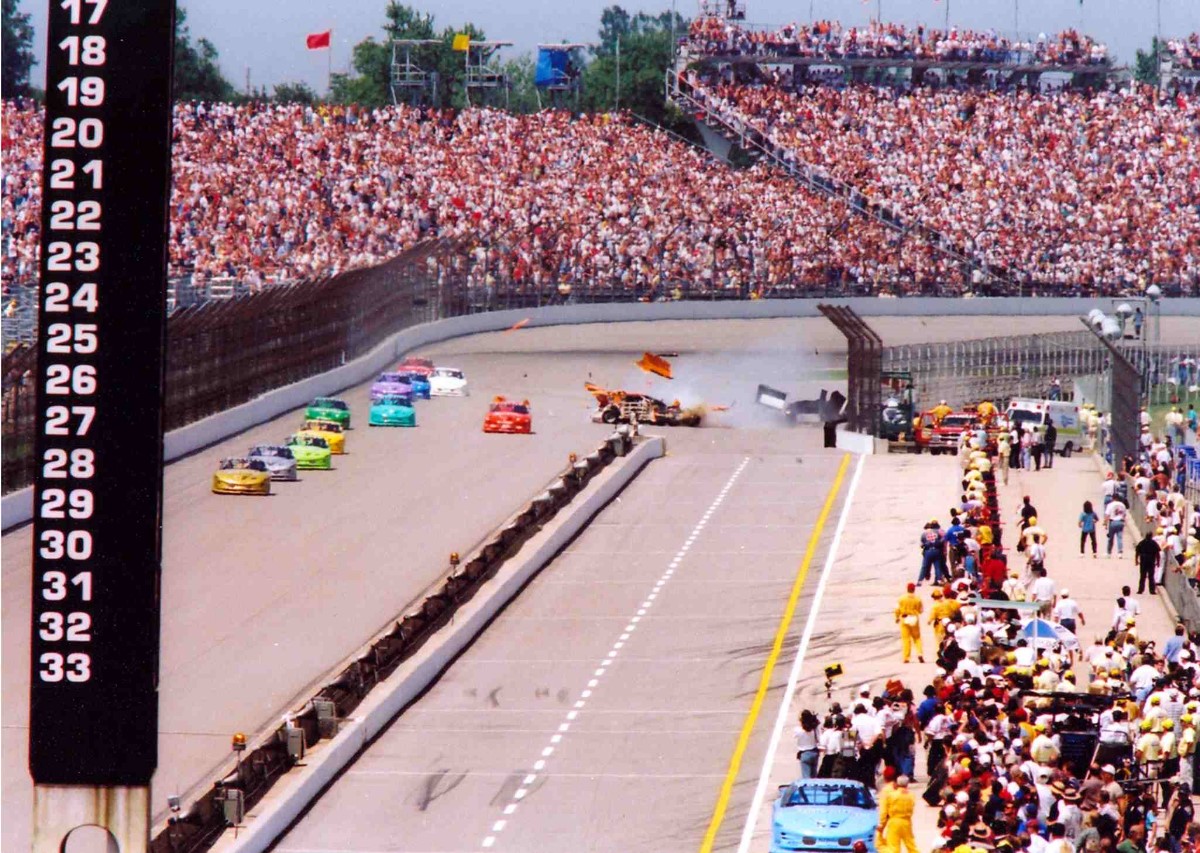IMS’ PEDS Barrier started SAFER Barrier revolution
 |
 |
| Original PEDS Safety Barrier |
Ten years ago, Indianapolis Motor Speedway and Indy Racing League officials were determined to take the next step in motorsports safety. What they produced was a revolution with a funny name: the PEDS Barrier.
Today the SAFER Barrier (Steel and Foam Energy Reduction) has gained international acclaim as an energy-absorbing barrier, credited with drastically reducing the level of injury or death on high-speed oval racetracks.
The truth is, without the research, effort and daring trials that marked the PEDS Barrier's short existence on the walls of the Indianapolis Motor Speedway, there might not have been a SAFER Barrier.
The Polyethylene Energy Dissipating System, or PEDS Barrier, was attached to the inside retaining wall at the exit of the Indianapolis Motor Speedway's Turn 4 on May 18, 1998, marking the first time in the track's storied history that an entity designed to soften crashes was attached to its concrete walls.
"The theory of 'soft walls' had been around since I could remember," said Leo Mehl, who served as executive director of the Indy Racing League from 1996-99. "I can remember lots of attempts to put foam on (walls). I remember Smokey Yunick designed a racetrack so the walls would give – the whole thing would move back. There had been a lot of ideas and attempts."
The problem with foam, however, is that it would worsen the accident by snagging the car, causing an unpredictable and often-violent reaction.
The PEDS Barrier consisted of 550 feet of 5-foot-long, overlapping high-density polyethylene impact plates that each contained two 16-inch-diameter cylinders made of the same material. The goal was for the cylinders to compress when impacted by a race car, reducing the force of impact while the plates would provide a smooth surface that would allow the car to move freely, unlike foam. Finally, thanks to polyethylene's flexible yet durable consistency, the PEDS Barrier would return to its normal configuration following the impact.
Mehl worked for Goodyear tire from 1959-1996, and spent the last 22 years managing the company's racing programs worldwide. He was no stranger to taking risks for the sake of improving racing safety.
"My personal opinion was, it's better to try something than not take the risk at all. Somebody has got to start this process, and nobody ever had," he said.
The Indy Racing League's safety committee, comprised of IMS and IRL officials, worked with retired GM Motorsports engineer John Pierce, who tested a number of the committee's barrier ideas with an impact sled-testing system at Wayne State University.
The committee knew it was on to something when the sled tests showed that the G-forces associated with a high-speed impact with an immovable concrete wall was reduced by 30 to 40 g's. The initial spike of energy, caused by the rapid deceleration associated with hitting an immovable object, is usually to blame for serious driver injuries, particularly head injuries.
Once the PEDS Barrier design was selected, the committee also did some "low-tech" testing at the Indianapolis Motor Speedway in spring 1998, before the track opened for 82nd Indianapolis 500 activities. Track officials placed several sections of the Barrier on the Speedway's walls and Mehl described, with several bursts of laughter, the test scene:
"It was a Chitwood Thrill Show technique," he said. "They went to a junkyard and bought two old heaps (cars) – two of the same model so you could do the same test twice. Joie (Chitwood, now IMS president and COO) rigged the steering wheels so we didn't have to have a driver in there. We towed the cars with wreckers, got it up to 50 mph, aimed at the wall, turned the wrecker at the last second and hit it (PEDS Barrier) twice. We were quite pleased with ourselves!"
After the test at IMS, Mehl said he lobbied IMS Chief Executive Officer Tony George to allow the IRL Safety Committee to place the previously-mentioned 550-foot section of PEDS Barrier at the exit of Turn 4.
Mehl gives George a lot of credit for giving the committee the go-ahead. Little did they know, within a few months a seeming defeat of their ideas would spark the move toward one of the most revolutionary creations in racing history.
"The bottom line is when you do anything different in racing, you take a great big risk of making the situation worse," Mehl said. "Tony George took a big risk to let us put that wall in. And so, there it started."
The PEDS Barrier was in place for Miller Lite Carb Day practice and the 82nd Indianapolis 500, but did not sustain any IndyCar Series car impacts. The 1998 Allstate 400 at the Brickyard weekend would be a completely different story.
The International Race of Champions (IROC) series made its debut at Indianapolis during the 1998 NASCAR Sprint Cup Series weekend. Two-time Indianapolis 500 winner Arie Luyendyk was among the IROC participants, enjoying his first opportunity to compete in a stock car at the fabled 2.5-mile oval where he won the "500" in 1990 and 1997.
 |
| On Lap 3 of the inaugural IROC race at IMS on July 31, 1998 Trans-Am champion Tommy Kendall made contact with the outside retaining wall exiting Turn 4 and bounced back into Arie Luyendyk's car, sending him into a spin – and headed straight toward the PEDS Barrier. |
On Lap 3 of the inaugural IROC race on July 31, Trans-Am champion Tommy Kendall made contact with the outside retaining wall exiting Turn 4 and bounced back into Luyendyk's car, sending him into a spin – and headed straight toward the PEDS Barrier.
Luyendyk's car did a 180-degree spin and hit the wall broadside on the right side of the car. The impact can only be described as immense – arguably the most violent stock car crash in Speedway history. It pulled several PEDS Barrier impact plates and polyethylene cylinders from the wall and spread debris – mostly PEDS materials and sheet metal from Luyendyk's IROC Pontiac – across the track.
"At that particular moment, I was with Tony (George) in his suite watching the IROC race," Mehl said. "When (Luyendyk) hit, he hit at a terrible angle, an angle that often results in injury. We went trackside and the Barrier had pretty much spread itself everywhere."
The two men were upset at the time, according to Mehl, because they felt like the PEDS experiment had failed. But they received a call from someone who knew Indianapolis Motor Speedway – and the nuances of car safety and accidents – like the back of his hand: A.J. Foyt.
"The interesting part was, Foyt was watching the replays from his suite over in Turn 2, and he called Tony right away and said, 'Tony, he probably wouldn't have walked away if that barrier wasn't there.' Foyt told Tony what I had said, that Luyendyk hit at the worst possible angle and was fortunate to be alive."
Luyendyk walked away from the accident with only a concussion, and was driving in the IndyCar Series two weeks later.
The accident proved that the PEDS Barrier had several flaws – primarily the springing action that had sent Luyendyk's car back into traffic and the debris field caused by the violent removal of the impact plates from their wall mounts. But clearly IMS and IRL officials were on to something – the PEDS Barrier had also saved a popular race driver from serious injury.
"We knew the Barrier had taken at least 30 or 40 g's off the hit, (but) as we cleaned up the debris the next Monday it became obvious that we needed to get some more help," Mehl said. "The most experienced guys we knew in the business for guardrails, attenuators and such, was the University of Nebraska."
The IRL Safety Committee made contact, in fall 1998, with Dr. Dean Sicking and his associates at the Midwest Roadside Safety Facility, located at the University of Nebraska-Lincoln.
Sicking and his associates added the scientific muscle and testing facilities required to build a barrier that would do everything the PEDS Barrier did to take the initial spike of energy off of impacts, but also move back into position slowly to prevent a car from "bouncing" back onto the track. The barrier also had to be strong enough to stay intact, and furthermore, it had to be compatible for both 1,500-pound IndyCars and 3,500-pound stock cars. Not an easy task.
Sicking recommended that the idea of using a polyethylene-skinned barrier be scuttled.
"From the word 'go' we knew that we needed to establish bending capacity in the skin and that polyethylene would never get there," said Sicking. "It's not stiff enough to keep it from wrapping around the front of a car."
Midwest Roadside Safety Facility officials recommended using a steel skin, and crash testing revealed that occupant safety increased 30 percent as a result.
Meanwhile, Speedway officials continued with the evolution of their work, installing an updated PEDS Barrier, called simply PEDS-2, at IMS in 1999. It would be impacted only once, in a relatively low-speed accident in Indianapolis 500 practice.
As development of a redesigned barrier continued in September 2000, IMS, IRL and Nebraska officials reached a point where, knowing that many tracks around the country played host to both 1,500-pound open-wheel cars and 3,500-pound stock cars, it was time to construct a barrier that withstood both high-speed open-wheel and stock-car impacts.
Brian Barnhart, the Indy Racing League's senior vice president of racing operations, met with NASCAR officials Mike Helton and Gary Nelson in September 2000 at Richmond (Va.) International Raceway, and NASCAR joined the program at that time.
NASCAR's involvement consisted of arranging for teams to provide stock cars for crash testing, by making a NASCAR official, the late Steve Peterson, available to help the University of Nebraska officials better understand the physical characteristics of stock cars and stock car crashes, and by providing part of the financing for the project from September 2000 on forward.
Nineteen months later, officials from the Indianapolis Motor Speedway, Indy Racing League, NASCAR and University of Nebraska Lincoln gathered at IMS for a landmark announcement on May 1, 2002 to introduce the SAFER Barrier.
George also used the occasion to announce that IMS had invested several million dollars to install the SAFER Barrier in time for the opening day of practice for the 86th Indianapolis 500.
After years of investment and investigation, it was a proud day for those involved. Mehl credits George for taking risks on a number of fronts.
"Regardless of what we needed in terms of finance, we would explain to him (George) what we needed and his attitude toward safety was, 'Whatever you have to have, you have to have,'" said Mehl. "He never questioned a penny that IRL spent on safety matters, especially development of the (energy-absorbing) walls.
"I spent most of my professional life in racing tires, so understand I'm not a safety expert, but I can't image any other safety feature that made so much difference," Mehl said. "Racing will never be completely safe, but it's safer now than it ever has been in my lifetime."
Information gathered from accidents involving the original SAFER Barrier resulted in today's second-generation SAFER Barrier, which graces the walls of most tracks. The Indianapolis Motor Speedway received its second-generation SAFER Barrier in March 2005, following a comprehensive repaving project.
Despite its success, one could feel safe making the assumption that the SAFER Barrier is not the final answer in energy-absorbing barrier technology. It is effective and it has saved numerous drivers from serious injury, but science is always on the move.
As motorsports history is written, the PEDS Barrier's life as the cutting-edge energy-dissipating technology will be considered extremely brief. But one fact simply cannot be taken away from the IRL Safety Committee members who are responsible for the PEDS Barrier: their efforts of 10 years ago, and the product of their efforts, fostered a revolution.
